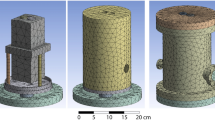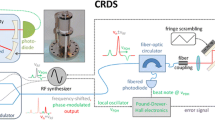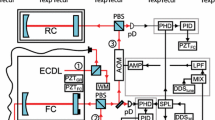Abstract
Optical feedback is an efficient way to narrow and stabilise semi-conductor lasers. As a step forward for ultra-stable, yet highly tunable sources, we developed a new prototype of a three-mirror V-shaped optical cavity (VCOF). It is made of a precisely machined Zerodur spacer, that holds 3 optical contacted mirrors forming a high finesse V-shaped cavity. This arrangement allows the resonant light to be sent back to the seeding laser, triggering a drastic narrowing of the emission linewidth well below the cavity mode width without the need for high-bandwidth active electronic lock of the laser on the cavity. Low expansion material and precise temperature control of the reference cavity leads to a source with Hz level frequency drift and 70 Hz-level emission linewidth at 215 THz. We discuss the benefits of this new prototype compared to its predecessor for high-sensitivity cavity ring down spectroscopy (CRDS). To serve this purpose, the frequency stabilised laser was characterised on short, mid and long time scales, using a high finesse etalon, a self referenced optical frequency comb and a long term saturated CRDS absorption Lamb dip measurement on water.






Similar content being viewed by others
References
P. Werle, Spectrochim. Acta Part A Mol. Biomol. Spectrosc. 54(2), 197 (1998)
E. Kerstel, L. Gianfrani, Appl. Phys. B 92(3), 439 (2008)
J.M. Hartmann, H. Tran, R. Armante, C. Boulet, A. Campargue, F. Forget, L. Gianfrani, I. Gordon, S. Guerlet, M. Gustafsson, J.T. Hodges, S. Kassi, D. Lisak, F. Thibault, G.C. Toon, Spectrosc. Radiat. Transf. (2018)
J. Landsberg, D. Romanini, E. Kerstel, Opt. Lett. 39(7), 1795 (2014). https://doi.org/10.1364/OL.39.001795
E.J. Steig, V. Gkinis, A.J. Schauer, S.W. Schoenemann, K. Samek, J. Hoffnagle, K.J. Dennis, S.M. Tan, Atmos. Meas. Tech. 7(8), 2421 (2014). https://doi.org/10.5194/amt-7-2421-2014
T. Stoltmann, M. Casado, M. Daëron, A. Landais, S. Kassi, Anal. Chem. 89(19), 10129 (2017)
M. Casado, Water stable isotopic composition on the East Antarctic Plateau: measurements at low temperature of the vapour composition, utilisation as an atmospheric tracer and implication for paleoclimate studies. Ph.D. thesis, Paris Saclay (2016)
D. Romanini, P. Dupre, R. Jost, Vib. Spectrosc. 19(1), 93 (1999)
P. Macko, R. Plašil, P. Kudrna, P. Hlavenka, V. Poterya, A. Pysanenko, G. Bánó, J. Glosık, Czechoslov. J. Phys. 52(2002 Suppl D), D695 (2002)
R.V. Pound, Rev. Sci. Instrum. 17(11), 490 (1946)
R.W.P. Drever, J.L. Hall, F.V. Kowalski, J. Hough, G.M. Ford, A.J. Munley, H. Ward, Appl. Phys. B 31(2), 97 (1983)
G.W. Truong, K.O. Douglass, S.E. Maxwell, R.D. van Zee, D.F. Plusquellic, J.T. Hodges, D.A. Long, Nat. Photon. 7, 532 (2013)
J.T. Hodges, R. Ciuryło, Rev. Sci. Instrum. 76(2), 23112 (2005)
V. Crozatier, F. De Seze, L. Haals, F. Bretenaker, I. Lorgeré, J.L. Le Gouët, Opt. Commun. 241(1–3), 203 (2004)
J. Burkart, D. Romanini, S. Kassi, Opt. Lett. 38(12), 2062 (2013)
P. Laurent, A. Clairon, C. Breant, IEEE J. Quantum. Electron. 25(6), 1131 (1989)
J. Morville, S. Kassi, M. Chenevier, D. Romanini, Appl. Phys. B 80(8), 1027 (2005). https://doi.org/10.1007/s00340-005-1828-z
F. Wei, F. Yang, X. Zhang, D. Xu, M. Ding, L. Zhang, D. Chen, H. Cai, Z. Fang, G. Xijia, Opt. Express 24(15), 17406 (2016)
A.D. Ludlow, X. Huang, M. Notcutt, T. Zanon-Willette, S.M. Foreman, M.M. Boyd, S. Blatt, J. Ye, Opt. Lett. 32(6), 641 (2007). https://doi.org/10.1364/OL.32.000641
J. Millo, D.V. Magalhaes, C. Mandache, Y. Le Coq, E.M.L. English, P.G. Westergaard, J. Lodewyck, S. Bize, P. Lemonde, G. Santarelli, Phys. Rev. A 79(5), 53829 (2009)
L. Rutkowski, A.C. Johansson, G. Zhao, T. Hausmaninger, A. Khodabakhsh, O. Axner, A. Foltynowicz, Opt. Express 25(18), 21711 (2017)
S. Kassi, T. Stoltmann, M. Casado, M. Daëron, A. Campargue, J. Chem. Phys. 148(5), 54201 (2018). https://doi.org/10.1063/1.5010957
R. Gotti, T. Sala, M. Prevedelli, S. Kassi, M. Marangoni, D. Romanini, J. Chem. Phys. 149(15), 154201 (2018). https://doi.org/10.1063/1.5046387
J. Burkart, T. Sala, D. Romanini, M. Marangoni, A. Campargue, S. Kassi, J. Chem. Phys. 142(19), 191103 (2015)
R.W. Fox, B.R. Washburn, N.R. Newbury, L. Hollberg, Appl. Opt. 44(36), 7793 (2005)
J. Ye, Q. Li, S.Q. Peng, Y.L. Chen, Appl. Opt. 29(12), 1724 (1990)
L.S. Ma, P. Jungner, J. Ye, J.L. Hall, Opt. Lett. 19(21), 1777 (1994)
G. Di Domenico, S. Schilt, P. Thomann, Appl. Opt. 49(25), 4801 (2010). https://doi.org/10.1364/AO.49.004801
N. Jobert, M. Casado, S. Kassi, Appl. Phys. B (2022). https://doi.org/10.1007/s00340-022-07779-x
J. Burkart, S. Kassi, Appl. Phys. B 119(1), 97 (2015). https://doi.org/10.1007/s00340-014-5999-3
Acknowledgements
The research leading to these results received funding from the European Research Council under the European Union's Seventh Framework Programme (FP7/2007-2013)/RC grant agreement number 306045, from the Agence Nationale de la Recherche (Grant ANR-13-JS060005), from Institut National des Sciences de l'Univers (LEFE/CHAT), from the Alexander von Humboldt fundation project DEAPICE. The authors acknowledge the technical support of Arnaud Dapoigny, David Terrier, Damien Capolongo and Hugues Guillet de Chatellus. The Zerodur spacer was built by Winlight Optics.
Author information
Authors and Affiliations
Corresponding author
Additional information
Publisher's Note
Springer Nature remains neutral with regard to jurisdictional claims in published maps and institutional affiliations.
Rights and permissions
About this article
Cite this article
Casado, M., Stoltmann, T., Landais, A. et al. High stability in near-infrared spectroscopy: part 1, adapting clock techniques to optical feedback. Appl. Phys. B 128, 54 (2022). https://doi.org/10.1007/s00340-022-07774-2
Received:
Accepted:
Published:
DOI: https://doi.org/10.1007/s00340-022-07774-2




